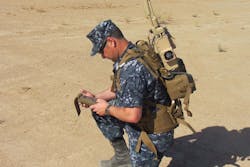Northrop to build electronic warfare (EW) RF jammers to protect warfighters from improvised explosives
WASHINGTON – Electronic warfare (EW) experts at Northrop Grumman Corp. are building additional open-architecture RF jammers for infantry, land vehicles, and fixed sites to protect Australian warfighters from radio-controlled improvised explosive devices (IEDs).
Officials of the U.S. Naval Sea Systems Command in Washington announced a $329.9 million order Wednesday to the Northrop Grumman Mission Systems segment in Herndon, Va., for Joint Counter-Radio-Controlled Improvised Explosive Device Electronic Warfare (JCREW) increment one block one (I1B1) systems for Australia.
The JCREW I1B1, formerly known as JCREW 3.3, is the first-generation system that develops a common open architecture across all three capabilities and provides protection with RF jammers for worldwide military operations, officials say.
Related: RF jammers for the electronic warfare (EW) battle against IEDs go into full-rate production
The order includes dismounted systems, mounted systems, mounted auxiliary kits, operational level spares, depot level spares, and engineering support services.
This integrated design for RF jammers makes the most of commonality across all capabilities, reduces life cycle costs, and provides increased protection against worldwide threats.
CREW systems protect combat troops from radio-controlled improvised explosives, and are designed to provide protection for foot soldiers, vehicles, and permanent structures, Navy officials say.
Among the JCREW I1B1 systems is the Northrop Grumman Freedom 240 for Counter Radio-controlled IED Electronic Warfare Marine Expeditionary Unit Special Operation Capable (SOC), or CREW MEU.
The system jams a wide range of IEDs and creates a protective barrier around Marine Corps infantry and their equipment while minimizing disruption to friendly communications systems.
On this order Northrop Grumman will do the work in San Diego and should be finished by December 2022. For more information contact Northrop Grumman Mission Systems online at www.northropgrumman.com, or Naval Sea Systems Command at www.navsea.navy.mil.
About the Author
John Keller
Editor-in-Chief
John Keller is the Editor-in-Chief, Military & Aerospace Electronics Magazine--provides extensive coverage and analysis of enabling electronics and optoelectronic technologies in military, space and commercial aviation applications. John has been a member of the Military & Aerospace Electronics staff since 1989 and chief editor since 1995.
